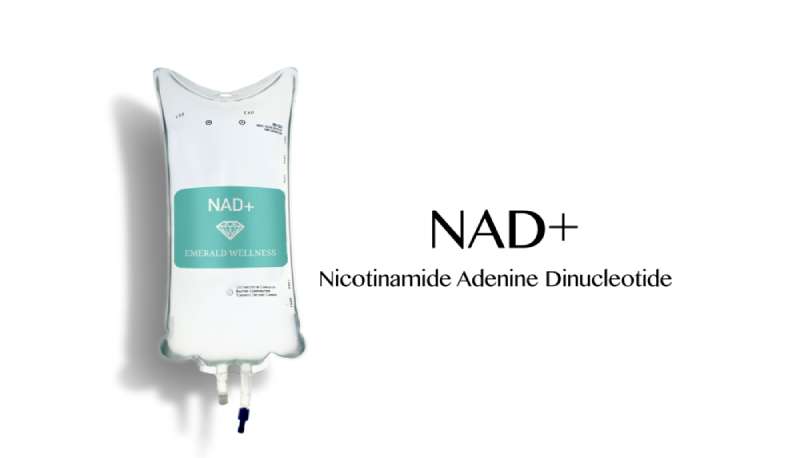Peptide Therapy in Las Vegas
What are Peptides?
Your body naturally makes peptides. They're a string of amino acids which are the "building blocks" of proteins. But a peptide doesn't have as many amino acids as a protein does.
Lab-made peptides can mimic some of those found in your body. Some of them are used in medications for conditions ranging from diabetes to multiple sclerosis. Studies have also found that certain types may have benefits for your skin, muscles, and possibly your weight.
Benefits of Peptide Therapy
- Repair and Recovery
- Weight Management
- Weight Loss
- Longevity
- Increased Growth Hormones
- Strengthens the Immune System
- Increased levels of memory retention and concentration
Peptide Therapy for Repair and Recovery

BPC 157
Composed of 15 amino acids, it is a partial sequence of body protection combound (BPC) that is discovered in and isolated from the human gastric juice. Experimentally, it has been demonstrated to accelerate the healing of many different wounds, including tendon-to-bone healing and superior healing of damaged ligaments.
BP-157 Benefits:
- Tendon healing
- Pain management
- Increase in collagen synthesis
- Faster recovery times post-injury
- Wound and bone healing
- Decrease in inflammation
- Helps with intestinal issues
- Improvement in heart health
- Reverse opiod dependance
- Enhances GABA neurotransmission
TB-500
TB-500 is a synthetic fraction of the 43 amino acid protein thymosin beta-4. The main purpose of this peptide is to promote healing. The healing effects of TB-500 have been observed in tendons, ligaments, muscles, skin, heart, and eyes.
TB-500 Benefits:
- Increased cellular healing
- Improves cell migration to the site of the injury
- Soft tissue repair: tendons, ligaments, athletic injuries
- Reduces scar tissue
- Improves mortality rate
Peptide Therapy for Weight Loss and Management

Semaglutide
Semagutide is a Glucagon-like peptide-1 (GLP-1) procuced by the gut. It increases insulin production, a hormone that lowers blood sugar levels while inhibiting glucagon secretion, which is a hormone that raises blood sugar levels,. It also reduces appetite and energy intake while deaying gastic emptying.
Semaglutide Benefits:
- Reduces food intake by lowering appetite
- Slows food digestion in the stomach
- Decreases body fat percentage
- Aids in weight loss
- Decreased cardiovascular outcomes in subjects with type-2 diabetes and cardiovascular disease
- Lower HbA1c levels
- Enchances the grown of β cells in the pancreas.
Tesofensine
Tesofensine is a dopamine, serotonin, and noradrenaline (triple) reuptake inhibitor originally developed to treat neurological disorders such as Parkinson's Disease and Alzheimer's disease. Although tesofensine was not efficient in PD trials, overweight participants achieved significant weight loss. Tesofensine was changed from development for these applications as it showed limited efficacy.
Tesofensine Benefits:
- Significantly decreased appetite
- Reduction in expected next meal size
- Decreased desire for sweet, fatty, or salty foods
AOD 9604
AOD 9604 is a modified form of amino acids 176-191 of the GH polypeptide. Investigators at Monash University discovered that the fat-reducing effects of GH appear to be controlled by a small region near one end of the GH molecule, it works by mimicking the way natural Growth Hormone regulates fat metabolism but without the adverse effects on blood sugar or growth that is seen with unmodified Growth Hormone. Like Growth Hormone, AOD 9604 stimulates lipolysis (the breakdown or destruction of fat) and inhibits lipogenesis (the transformation of nonfat food materials into body fat) both in laboratory testing and in animals and humans alike.
AOD 9604 Benefits:
- Reduces body fat
- Regulates fat metabolism
- Stimilates lipolysis
- Inhibits lipogenesis
- Triggers fat release
Peptide Therapy for Increased Growth Hormone Production

Sermorelin Plus
Has all of the benefits of Sermorelin plus the added benefits of Ipamorelin and Glycine. Ipamorelin is a synthetic pentapeptide, a selective agonist of the ghrelin/ GHS receptor pathway. Ipamorelin selectively binds the GHSR-1a receptor in the brain. This interaction with GHSR-1a leads to a GH release from the pituitary gland, influencing several anabolic processes, including appetite regulation, fat processing, and overall energy usage. Studies have shown that Ipamorelin can be found in the gastrointestinal tract, heart, lungs, kidney, pancreas, liver, immune cells, and adipose tissue. Glycine is one of the stimulatory agents inducing the pituitary gland to secrete HGH.
Sermorelin Plus Benefits:
- Improvements in well being and libido
- Augmented restful sleep leads to better cognitive functions
- Refined skin tone with stronger hair and nails
- Decrease in mean systolic blood pressure
- Improvement in fat loss and lean mass gains
- Increased endurance and strength
- Significant increased in GH release two hours after administration
- Elevated mean 24-h GH, peak GH amplitude, and GH area under the peaks
MK-677 (Ibutamoren)
This is a hormone secretion compound that stimulates the pituitary gland to increase the production of human growth hormone. Ibutamoren is a long-acting, orally active, selective, and non-peptide agonist of the ghrelin receptor and a growth hormone secretagogue, imitating the growth hormone (GH)-stimulating action of the endogenous hormone ghrelin.
MK-677 Benefits
- Increases IGF-1 Levels in as little as two weeks
- Longer REM sleep and shorter sleep latency
- Increases fat-free muscle mass
- Decreases body fat percentage
- Increase in bone strength
- Improves endurance
- Increases nitrogen levels in the body
- Reversal of nitrogen wasting
Peptide Therapy for Immune Health and Longevity

Epitalon
Epitalon is a tetrapeptide composed of four amino acids (alanine, glutamic acid, aspartic acid, and glycine). It is a synthetic version of Epihalamine, a peptide extract of the pineal gland—developed in Russia in the 1980s. In the early 2000s, excitement about Epitalon increased even more, when scientists found it could activate telomerase, leading to the regrowth of telomeres. Recent studies indicate that telomere length, which can be affected by various lifestyle factors, can affect the pace of aging and the onset of age-associated diseases. Telomere length shortens with age. The progressive shortening of telomeres leads to senescence, apoptosis, or oncogenic transformation of somatic cells, affecting the health and lifespan of an individual. Shorter telomeres are associated with increased incidence of diseases and poor survival. The rate of telomere shortening can be either increased or decreased by specific lifestyle factors. Better choice of diet and activities has great potential to reduce the rate of telomere shortening or at least prevent excessive telomere attrition, leading to delayed onset of age-associated diseases and increased lifespan.
Epitalon can provide you with better sleep and strengthen the immune system. Studies reveal increasing the cognitive capacities of your brain and bio-regulate your whole body through the action of the pineal gland and an increase in melatonin secretion. It has been intensively tested in Russia for more than 25 years for its anti-aging and enhancing properties. More people around the world increasingly use it.
Epitalon Benefits:
-
Increase in the life length by prolonging the telomeres in human cells.
-
Prevention of age-related declines to physical endurance.
-
Rebalanced melatonin production and circadian rhythm.
-
Normalized carbohydrate and fat metabolism.
-
Decreased rates of hypertension and cardiovascular disease.
-
Better management of metabolism and body weight.
-
Improved endocrine health.
-
Reduced incidence of acute respiratory disease.
-
Lower rates of osteoarthritis and osteoporosis.
-
Rehabilitation of nervous system activity.
-
Improve physiological functions, and reduce mortality by almost 50% after 15 years.
-
Works as an antioxidant by reducing Lipid oxidation and ROS and normalizes T cell function.
-
Repairs damaged and weakened muscle cells.
Glutathione
Glutathione is an antioxidant produced in cells. It’s comprised mostly of three amino acids: glutamine, glycine, and cysteine. Glutathione injections work by clearing the body of toxins and free radicals. When we are exposed to toxins, glutathione is used up faster than it can be produced. Glutathione levels in the body can be reduced by many factors, including poor nutrition, environmental toxins, and stress. Its levels also decline with age.
Glutathione Benefits
-
Reduces oxidative stress.
-
Brighten skin and help improve skin tone.
-
Decrease the body of free radicals and toxins.
-
May minimize respiratory disease symptoms.
-
Reduces cell damage in alcoholic and nonalcoholic fatty liver disease.
-
Improves insulin resistance in older individuals.
-
Increases mobility for people with peripheral artery disease.
-
May reduce the impact of uncontrolled diabetes.
-
May help fight against autoimmune diseases.
NAD+ Therapy in Las Vegas

NAD+ was first described in 1906 by Harden and Young as a cell component thatenhanced alcohol fermentation ( Harden and Young, 1906 ). Then in 1936, Warburg showed that NAD is required for redox reactions ( Warburg and Christian, 1936 ) and solidified the nomenclature: “NAD” refers to the chemical backbone irrespective of charge, “NAD+” and “NADH” refer to the oxidized and reduced forms respectively.
High dose intravenous infusion of pure NAD+ goes directly into the cell, bypassing the digestive system for better absorption. NAD+ is quick to repair the cells in your body and neurons in the brain.
NAD+ Therapy in Las Vegas can help alleviate many chronic conditions such as:
- Addiction
- Chronic Fatigue
- Chronic Stress
- Lack of Energy
- Depression
- Drug Abuse
- Anxiety
- Addiction
- Liver Disease
- Chronic Pain
NAD+ Positively affects the following functions in the body:
Liver Function: Key enzymes in NAD + signaling pathways are known to protect the liver from fat accumulation, fibrosis, and insulin resistance, which are related to the development of fatty liver diseases, such as NAFLD and NASH.
Kidney Function: Several lines of evidence indicate that reduced levels of NAD + in aged kidneys and a corresponding decrease in sirtuin activity are largely responsible for reduced kidney function and resilience with age (Ugur et al., 2015 ).
Skeletal Muscle Function: Old mice have increased markers of muscle atrophy and inflammation, as well as impaired insulin signaling and insulin-stimulated glucose uptake compared to young wild-type mice. Treatment of old mice with NAD+ precursors, such as NR and NMN, dramatically improves muscle function.
Cardiac Function: NAD+ levels are critical for normal heart function and recovery from injury.
Endothelial and Vascular Function: Cardiovascular and cerebrovascular diseases contribute to the greatest decline in quality of life after 65 and are directly responsible for about one-third of all deaths ( Nichols et al., 2014 ; Ungvari et al., 2010 ).
DNA Repair and Cancer: Because NAD+ is involved in so many aspects of cancer biology, from mitochondrial activity to cell survival, there are a variety of ways it could be used in the clinic. The rationale for reducing NAD+ levels in tumors is that they will be less able to repair DNA damage, thereby increasing their sensitivity to chemotherapeutic agents.
Immunity and Inflammation: There is a growing body of evidence that NAD+ precursors can have anti-inflammatory effects.
Neuronal Function: The neuroprotective effects of NAD + precursors were first revealed by a study of the middle cerebral artery (MCAO)-induced ischemia, where treatment with NAM reduced the extent of infarct in Wistar rats ( Ayoub et al., 1999 ; Klaidman et al., 2003 ; Sadanaga-Akiyoshi et al., 2003 ), a finding recently replicated by treatment with NMN ( Wei etal., 2017a).
Aging and Longevity: Total NAD + levels were once considered extremely stable. Recently, however, it has become clear that a steady decline in total NAD + levels over time is a natural part of life for all species, from yeast to humans ( Balan et al., 2008 ; Belenky et al., 2007 ; Lin et al., 2004 ; Massudi et al., 2012 ; Mouchiroud et al., 2013 ; Zhang et al., 2016 ; Zhu et al., 2015 ). This decline, along with the decreased activity of NAD + signaling proteins, is believed to be one of the major reasons organisms, including humans, age.
A decline in NAD+ during aging is believed to be a major cause of disease and disability, such as hearing and vision loss, as well as cognitive and motor dysfunction, immune deficiencies, auto-immunity, and dysregulation of the inflammatory response leading to arthritis, metabolic dysfunction and cardiovascular disease. In mouse models, NAD+ boosters prevent or treat a variety of different diseases, prompting a search for NAD+ boosters that are safe and effective as drugs to treat both rare and common diseases, and potentially aging itself.
Tags: peptides peptide therapy repair recovery weight hgh weight management




